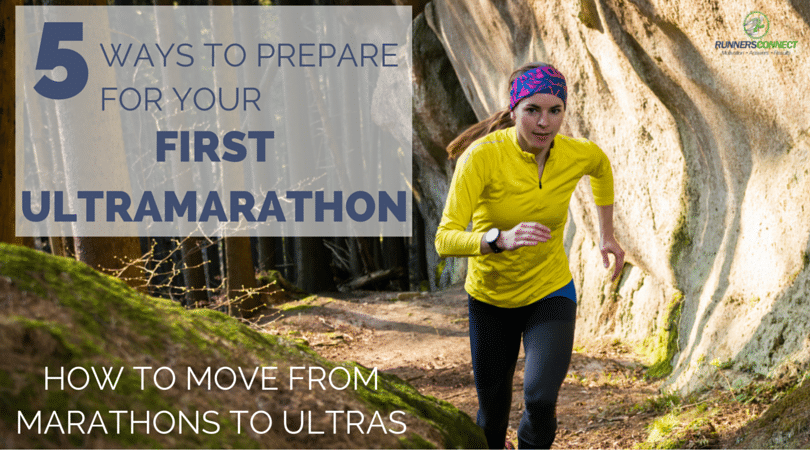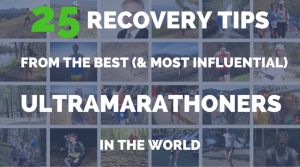A few years ago you did not even know how far a 50k is in miles, you wondered what is an ultramarathon when other runners talked about racing their first ultra, and the idea of running more than a marathon made you feel nauseous.
Fast forward a few years, not only is the temptation to run your first ultramarathon there, but you are deep into researching how to train for your first ultramarathon.
It is a scary new world (although not as scary as we think) moving into the world of ultra running, but what about if you have only ever run marathons, and only know one way to race.
Surely a 50 mile training plan will differ drastically to your previous marathon training schedule?
Today we are going to show you exactly how to prepare for your first ultramarathon, and how you can adjust your training from the marathon in 5 ways to make sure you are ready, both physically and mentally for your first ultra race.

Ultra runners are often seen as the holy grail of runners; the toughest of them all. An exclusive club that only the truly hardcore can even think of applying.
But I’ll let you into a secret:
Ultras are not as hard as you might think.
In fact I believe a 50km trail ultra is actually easier than a road marathon.
Running an Ultramarathon Easier than Running a Marathon
Yes, you did read that correctly.
Here’s why:
During a road marathon your legs repeat the same movement over and over, pounding the hard tarmac.
Every footstrike is identical. It’s relentless, repetitive and painful.
The focus is on time, splits and maintaining pace.
You want to do your best and most marathon runners try to run the fastest time they can over the distance.
A trail ultra on the other hand is relaxed and fun, and although you have to run a bit further (an ultra is basically anything longer than marathon distance), it’s much less stress on your body due to the mixed terrain, pace and run/walk approach and it’s just… well… easier.
Why is that the case?
Relaxed setting
The atmosphere at an ultramarathon is more chilled- think fun day out with your friends, usually with cake.
Don’t believe me? Listen to any of the podcast episodes with ultra runners (Travis Macy, Chris McDougall, Ellie Greenwood, Stephanie Howe), they are definitely more laid back than most the other runners we have on the show!
Relaxed pace
The pace is much more relaxed
Contrary to what most runners might think, walking is not frowned upon or seen as a failure in an ultra.
In fact in the ultra running world it’s positively encouraged.
There generally isn’t the pressure on time and therefore you can just trot along at your own comfortable pace, enjoy the view, walk up the hills, have a nice chat to your buddies and focus on simply crossing the line.
But when you crawl over the finish line of the marathon it’s hard to imagine being able to run another step.
How to Move from the Marathon to Training for Your First Ultramarathon
The goal (for 95% of runners) of an ultra is simply to finish it.
Time simply does not matter.
Apart from a tiny group of elite runners who are competitive at ultra distance running, the main focus for most of the field will just be to get to the finish line.
Preferably in one piece.
Mark Laithwaite – endurance coach and race organiser for the Lakeland 100 in the UK – agrees, ‘running has changed a lot in the last few years.
It’s more about participation and experience than ever before and ultra running is growing fast.
Ultra running is very different to the marathon.
People coming up from the marathon have a natural running pace, they find it hard to get their head around the fact they have to slow down to run an ultra.
If you want to run an ultra, there is only one thing you have to do.
Want to know the secret to success in an ultra?
Slow down.
That’s it!
Avoid setting time goals or targets and just focus on completing it’.
If you can run a marathon, you have the physiological fitness to run a 50km ultra.
Period.
You don’t have to train harder, or longer or do much differently.
If you’ve got the physiological fitness for the marathon, any additional miles are simply about mental toughness, the right fuel and fluid, pacing correctly and not breaking.
Once you get your head around the fact that it’s simply a ‘long day out’ on the trail, you can train for it properly.
Approach your training differently to marathon preparation.
‘You need to train to walk as well as run’ explains Mark ‘ in fact you SHOULD walk, especially on the hills’.
This is such an alien concept for most runners, it’s probably the hardest thing to get your head around.
Plan to do some long hikes as part of your training, wearing the same kit as you would when running. Find hills, hike up them and get your legs used to different paces.
‘Having a tool of some sort to slow you down is a good tip’ Mark continues ‘use a heart rate monitor set to beep if you go over a set zone – or some strategy to keep you running slowly. The maffetone method works well for ultra runners’.
Aim to do all your long runs like this, and mix up the rest of your training.
Get used to the run/walk approach and walk up steep hills.
Keep your heart rate down to conserve energy and glycogen stores.
You should find you’ll recover from these runs faster than a traditional long marathon run, so the ability to increase your weekly mileage is usually easier.
But just let it come to you, rather than chase the mileage too hard.
Listen to your body and see how well it’s recovering.
Having the ability to avoid injury is probably the next important aspect of preparing for an ultra.
The ability to recover well and knock out higher mileage – at a slower pace – is the key to ultra success.
So once you’ve got your run/walk running technique sorted, the next thing you need to include is some strength work in your training.
Mark Bayliss, former World record holder for the Enduroman Arch to Arc Triathlon is an example of how important strength training is for ultra distance athletes:
‘My training for the Arch to Arc (London to Paris triathlon) was pretty unconventional’ explains Mark
‘I worked really long hours in my job, so doing the standard long runs and bike sessions was impossible. Instead I joined a boxing gym and got really, really strong with weight training.
I knew I had the cardio fitness for the event, but what I needed was the ability not to break and to stay strong towards the end when I was fatigued’.
It worked as Mark completed the Arch to Arc in 2012 and was the first person to do it without a wetsuit.
Think outside of the box.
You don’t have to ‘just run’.
Try to include a couple of sessions of strength work each week, and some long bike rides too.
Being able to avoid injury – both in training and during the race itself – is your secret weapon which leads to better consistency and stronger running.
Doing less mileage, but more strength work, might not seem logical, but it works and is especially important for ultra runners.
Using a foam roller and a range of massage tools is also an easy fix to keep you on the road and injury free. The Tiger Tail is an amazing tool for your quads, adductors and calves.
The more mileage you do, the more you need to take care of your body with massage, foam rolling (just don’t make any of the 4 common mistakes!) and conditioning work.
Try to include 3-4 sessions (of 20-30 mins) of rolling and massage ball work every week.
In a normal road marathon, there will be water stations and sports fuel products on offer almost every mile.
In a trail ultra, you might be lucky if there is one water station the whole event.
You’ll also be on the go for much longer than you would in a conventional road marathon, and you’ll basically need to eat proper food at some stage.
Getting used to eating solid food on the run is an odd concept for most marathon runners. But your pace will be much slower when you’re running an ultra, and you’ll be able to digest solid food much more easily without gastric upset.
In my first ultra (Lakeland 50 miles) I was surprised to find fuel stops serving pasta, cake and smoothies… but you soon realize that you need it.
And not only do you need it, you can tolerate far more solid food at a slower pace.
One ultra race I did in India served cold potatoes covered in salt. On day one I turned up my nose, but by day 5 I couldn’t stop scoffing them!
Your body will tell you what it needs.
The ability to eat and digest on the run does take some practice however, so use your long training runs to start with small amounts of more solid food.
You’ll need more than sweets, gels and drinks.
Experiment with granola bars, rice balls and small sandwiches. Some runners like sesame snaps and beef jerky. Just find what works for you.
Skratch Labs Portables Cookbook has some great ideas for portable snacks.
We love the peanut butter and jelly rice cakes.
Hydration is another vital aspect of ultra running. You’ll need to carry your fluid with you (see my previous article on what to pack in your bag) and not just rely on drink stations – which could be miles apart.
By carrying your own drink, you’ll be more in control of your hydration.
Choosing a drink containing electrolytes is essential.
Your risk of dehydration is greater the longer you run, and you need a drink you can tolerate well so experiment in training.
Newer sports drinks have less sugar, more electrolytes and are better absorbed by the body for optimal absorption. If you want to avoid the sugar all together, try EnduroPacks electrolyte spray that can be added to any drink, and aim to consume around 200-600 ml per hour depending on conditions and your own needs.
The thing that surprises people most about ultra running is the rapid fluctuation of feeling great and feeling terrible.
I did a 100 mile stage event in the Himalayas a few years ago, I shared this story of racing with a colostomy bag on a previous episode of the Run to the Top podcast.
By day 4 I thought I was dying.
But on the final day, I knocked out 17 miles with ease and felt like I was flying.
It’s surprising what the body can do.
Mark Laithwaite explains ‘In a normal marathon you get a gradual drop off of pace and generally feel worse and worse until you cross the line. In an ultra, there is much more fluctuation.
You can be going through a bad patch, but then very quickly feel better and have a good spell.
It’s really important for ultra runners to accept that there’ll be good and bad patches and just to work through them.
You can only deal with the here and now.
I’d avoid setting goals and times, as it just makes you feel worse. In my experience the runners who set target times are the ones who drop out.
Accept that there’ll be times when you’re struggling, but know that it won’t last and that you’ll get through it’.
Feeling better about preparing for your first ultramarathon?
Make sure you read this article on the 9 things you need to do before you race your first ultra, and if you need any advice on the logistics of how to train for your first ultra, we have that too!
RunnersConnect Bonus
Download your FREE Ultra Runners Checklist.
Giving you an easy to follow, printable list of the 9 steps to follow as you prepare for your first (and every) ultra marathon.







